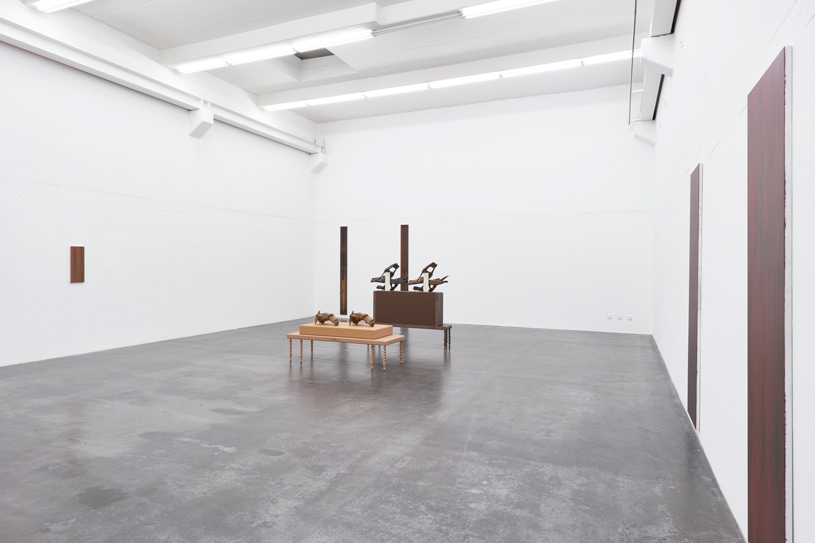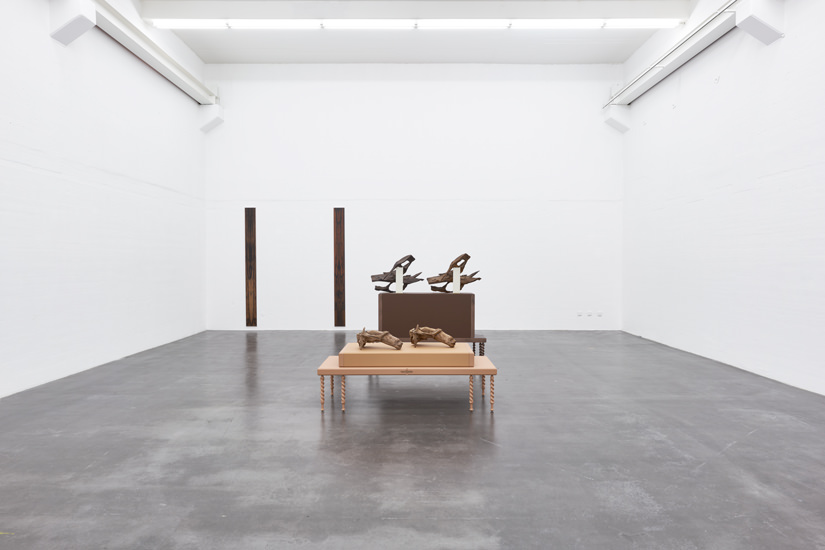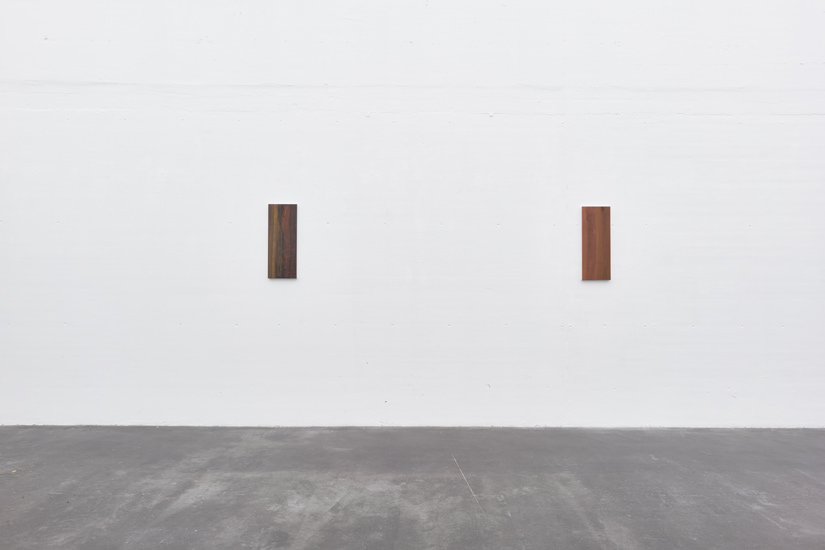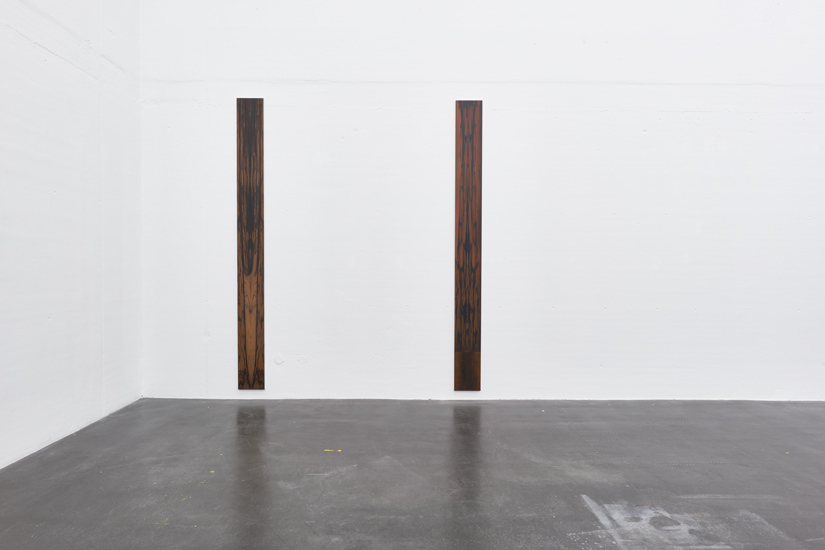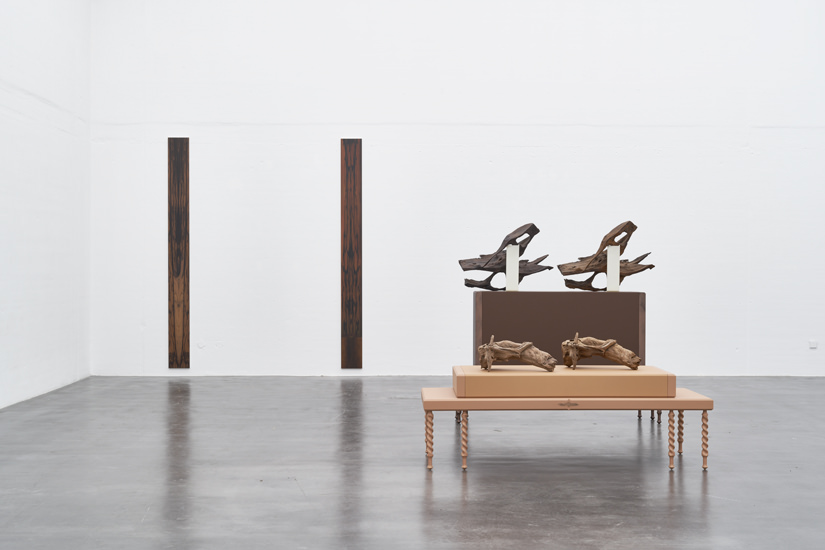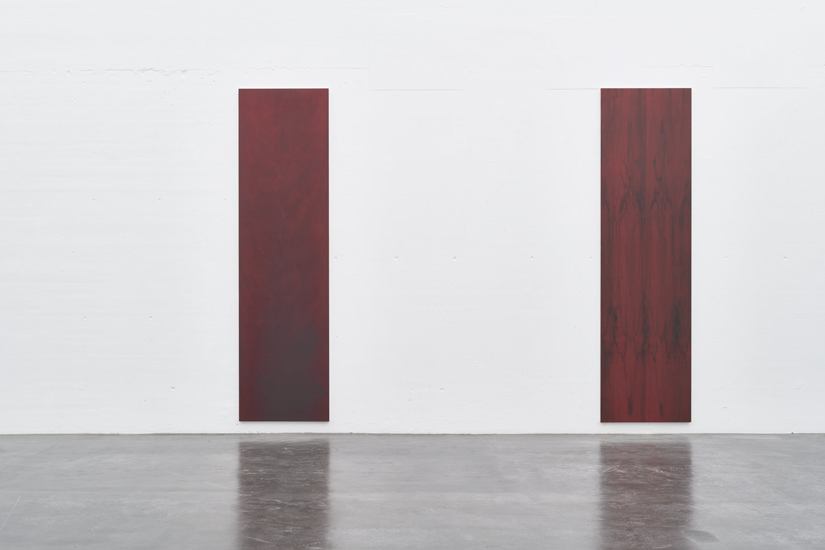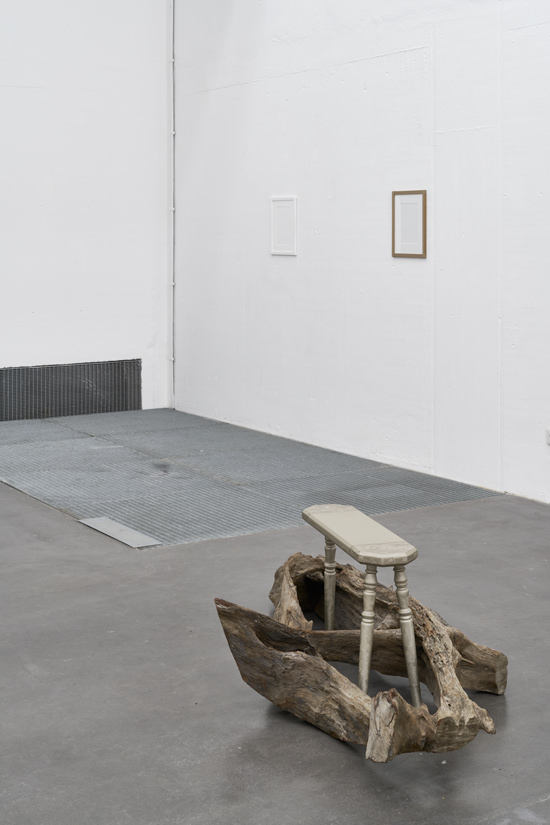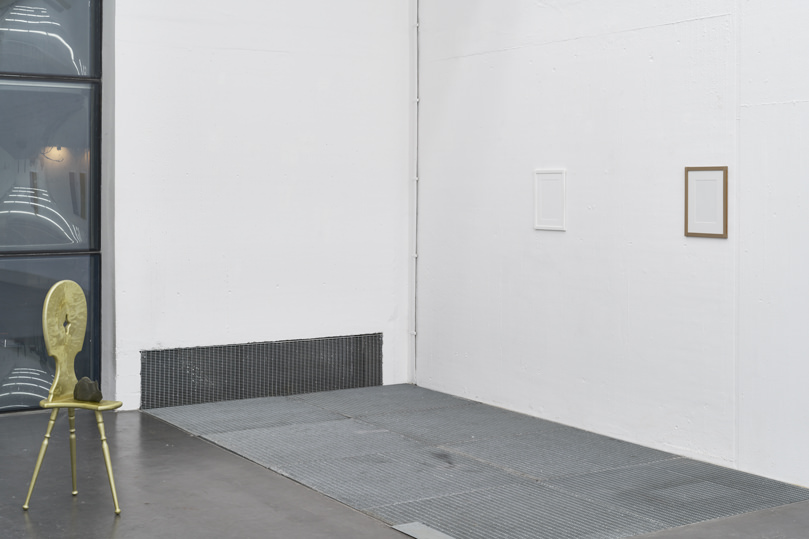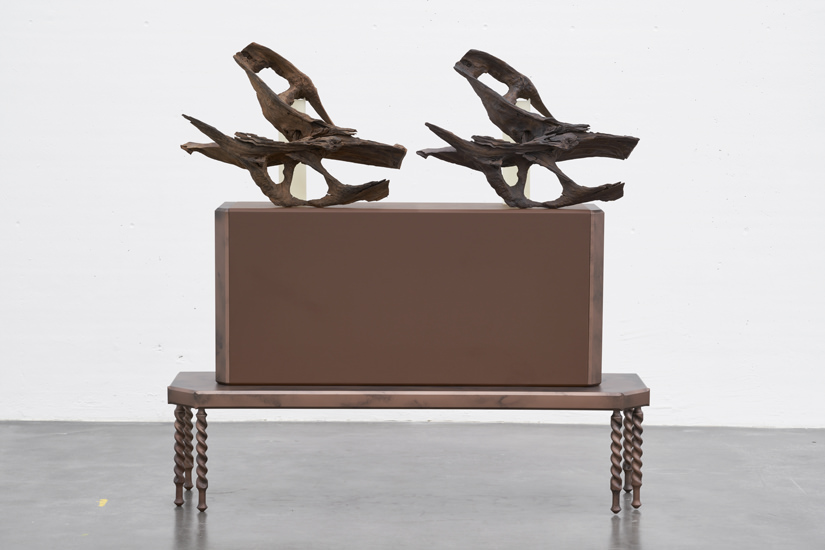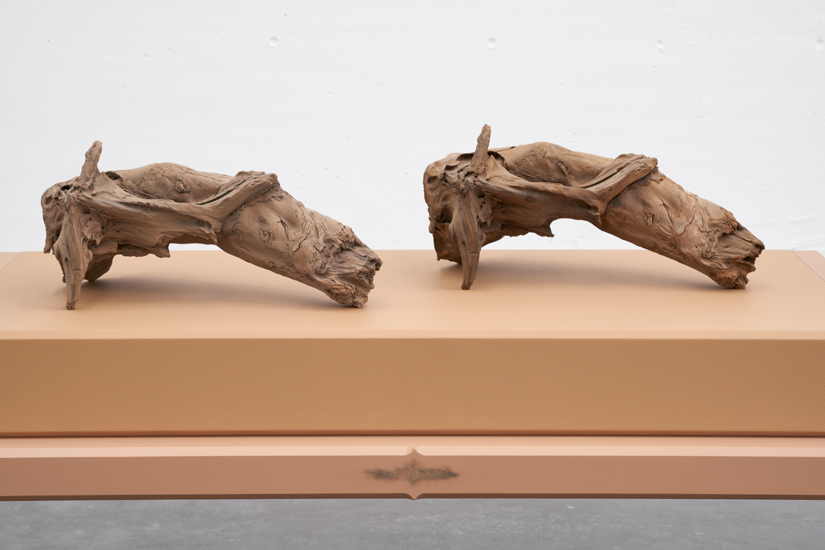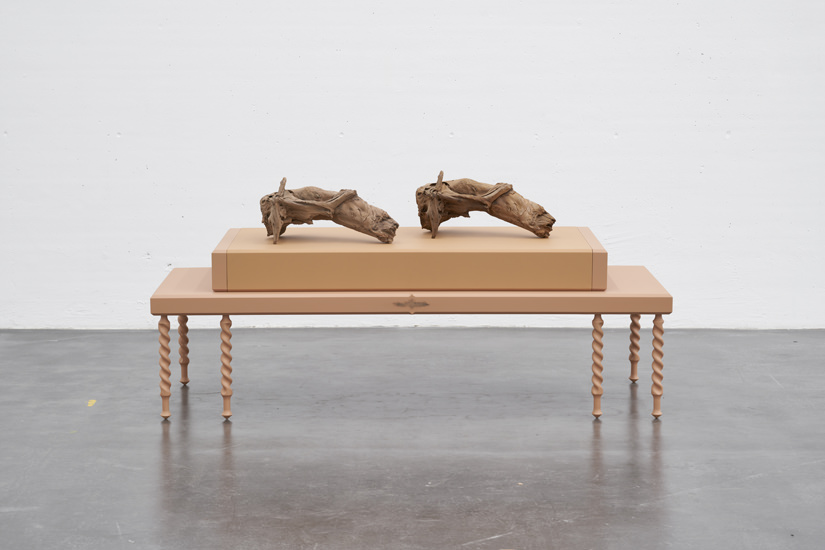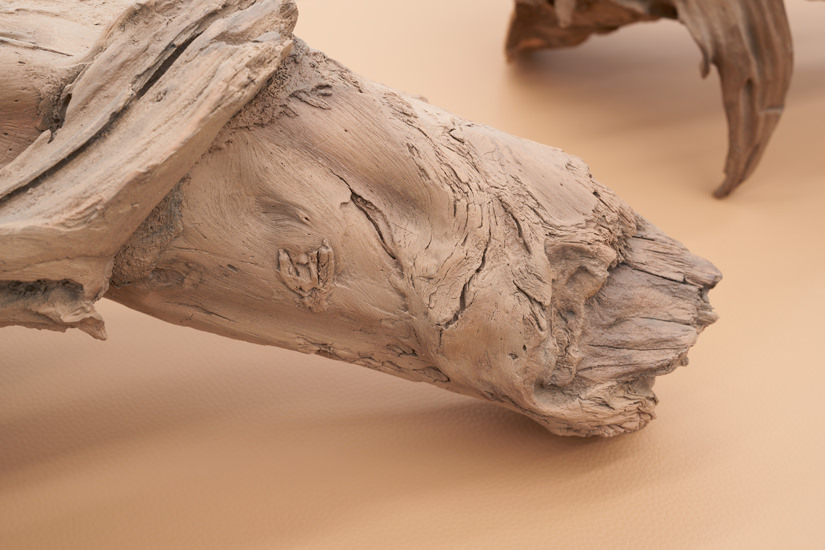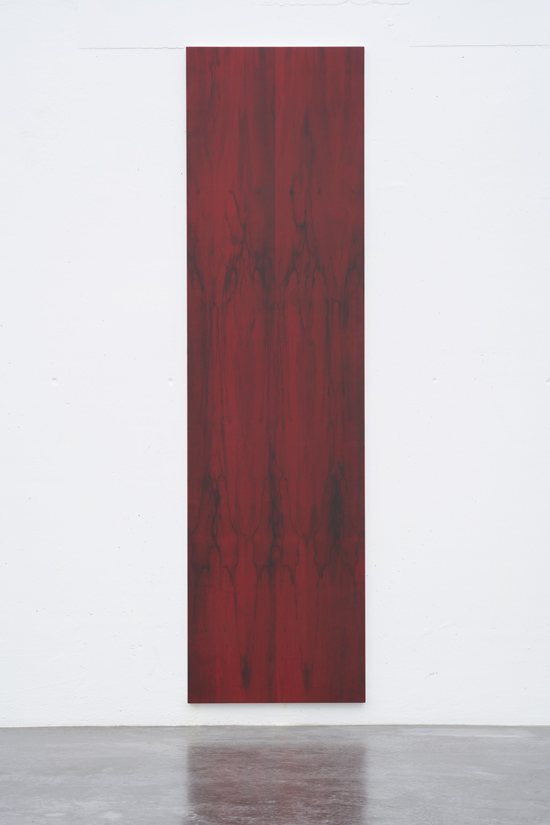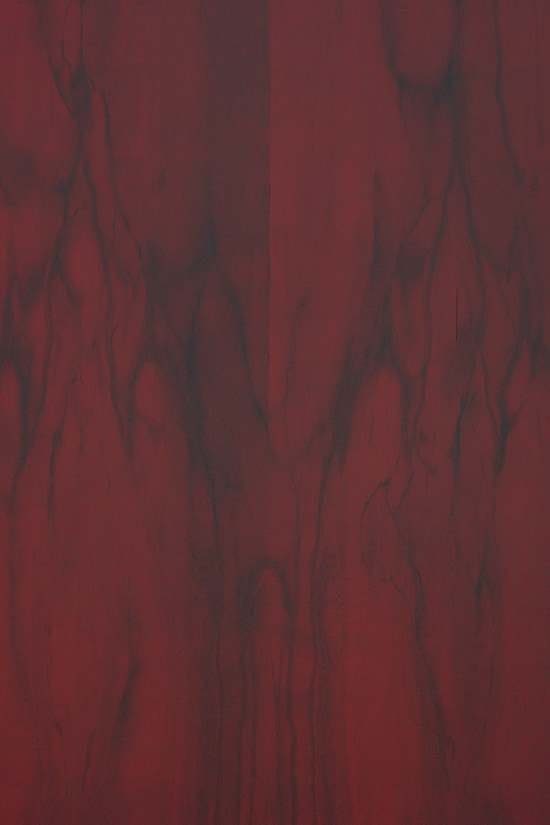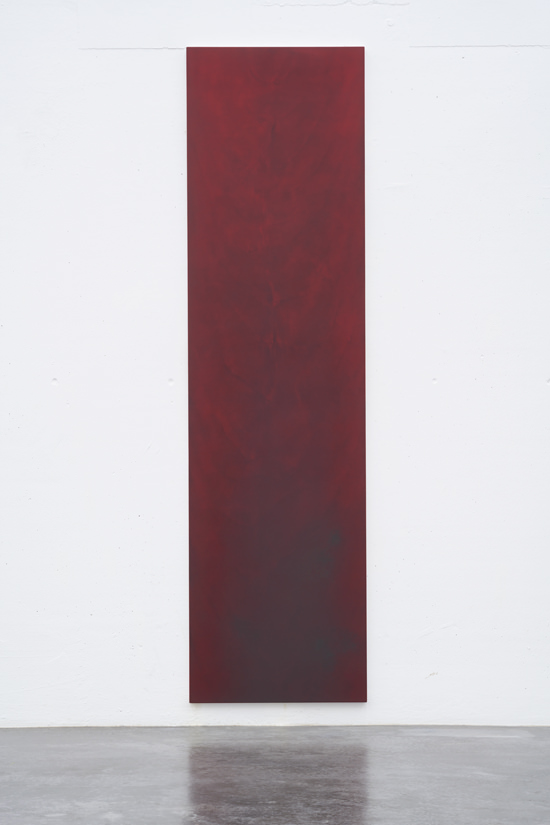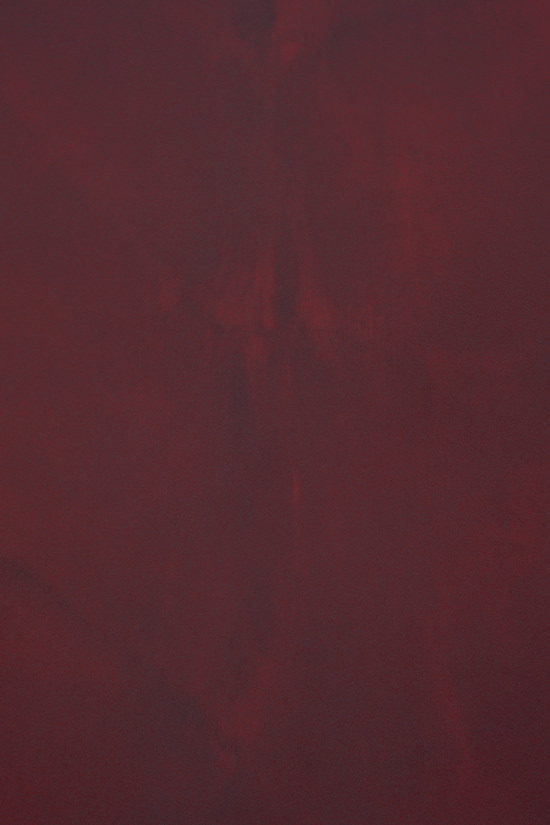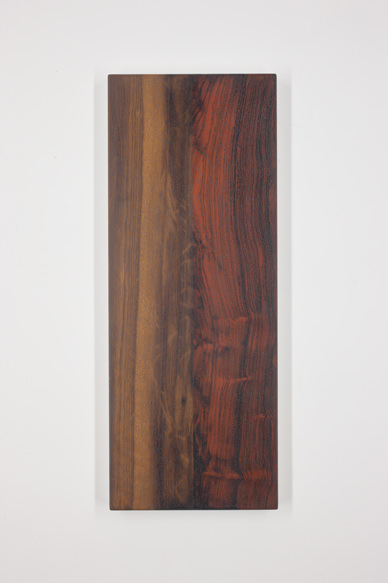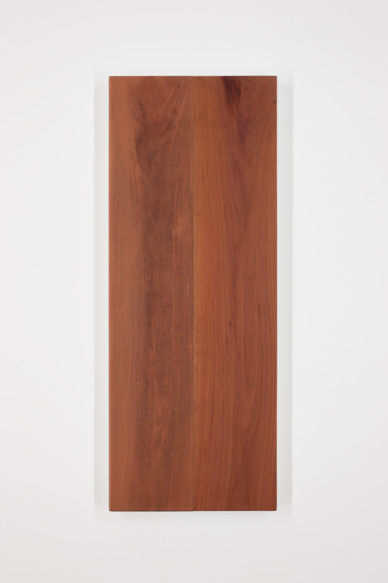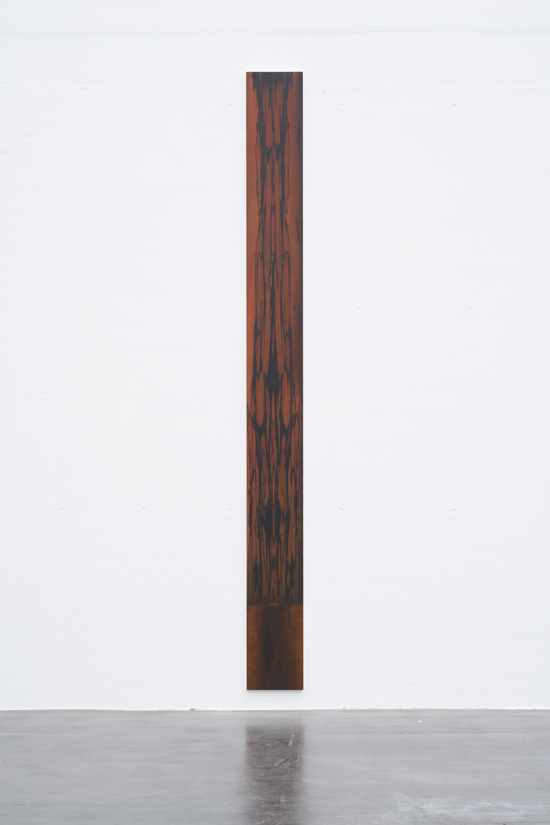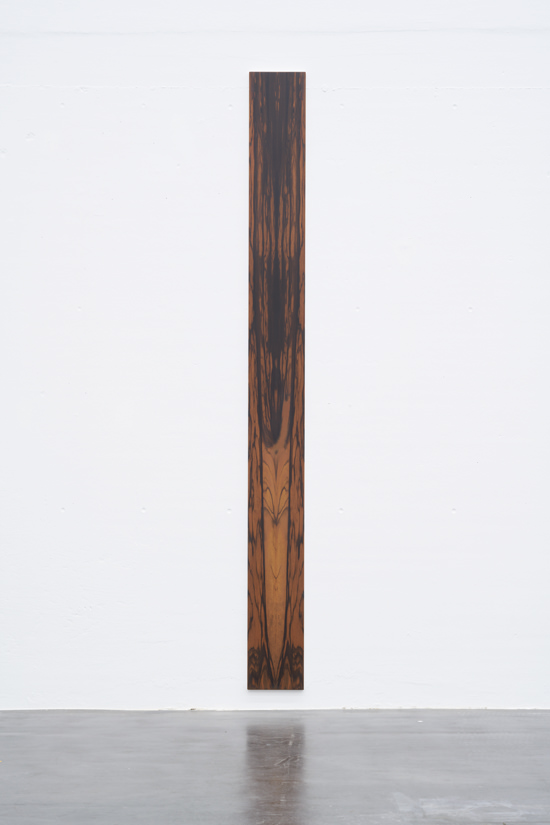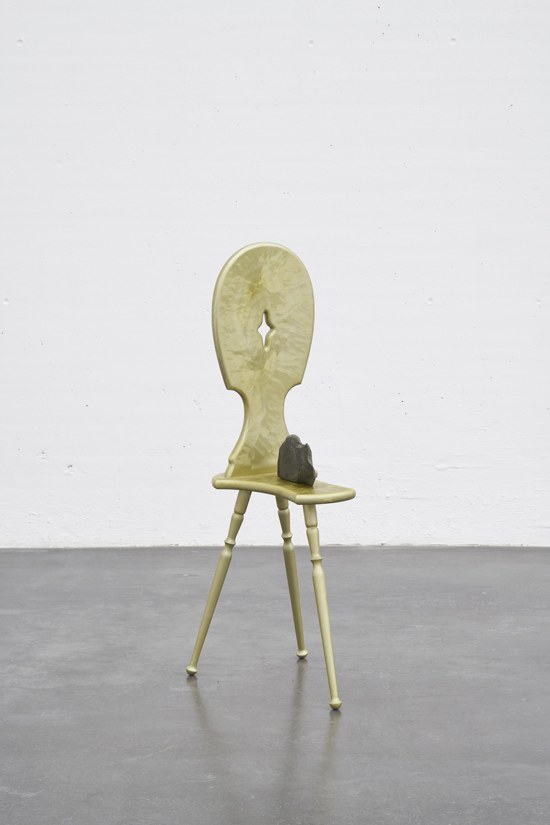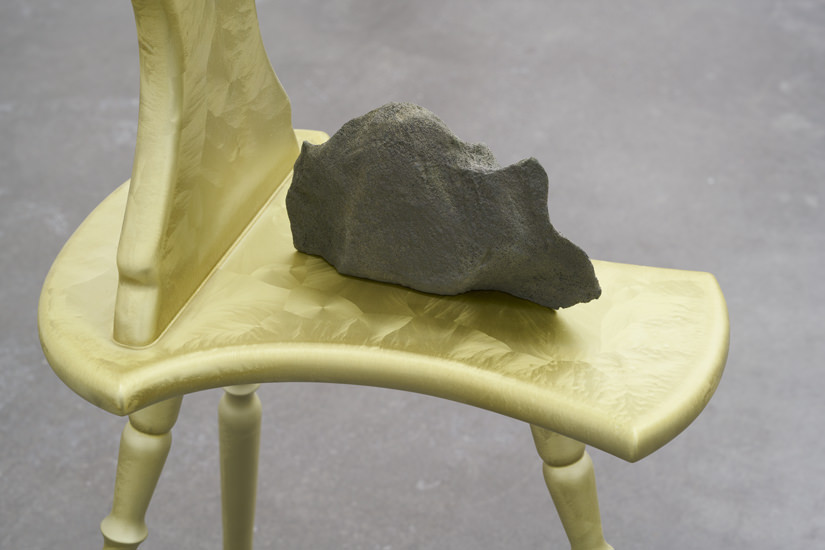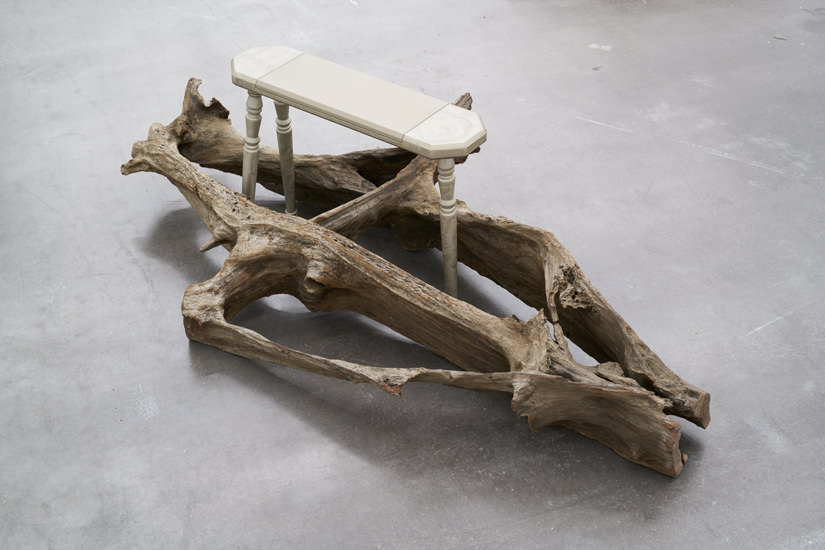PHILIP SEIBEL „Die Zuversicht der Dinge“
Jan 20 – Feb 18, 2017
Installation Views (for text in English & German scroll downwards)
Ausstellungstext – Deutsch (for English version scroll downwards)
PHILIP SEIBEL: „Die Zuversicht der Dinge“
- Januar – 18. Februar 2017
Die Galerie Berthold Pott freut sich, die zweite Einzelausstellung von Philip Seibel (Jhg. 1980) in der Galerie zu präsentieren.
Seibel zeigt in der neuen Ausstellung „Die Zuversicht der Dinge“ drei Paare aus seiner Reihe der „Tafeln“ (Malerei auf Aluminiumwabenplatte bzw. Malerei auf holzfurnierter Aluminiumwabenplatte), Skulpturen, die sich zwischen Objekt, Fundstück (Holzwurzel), Möbel und Interieur bewegen, sowie zwei filigrane Bleistiftzeichnungen von Wuchsstrukturen.
Die „Tafeln“ definieren die Struktur im Holz zum eigentlichen Bildthema. Entweder unter Verwendung von echtem Furnier, kaschiert auf einer Aluminiumwabenplatte, oder als Imitation der Holzmaserung, die unter Einsatz von Pigmenten, Lacken, speziellen Pinseln, Schleif- und Polierprozessen auf das Aluminium gemalt wird.
Im Zentrum der aktuellen Ausstellung stehen zwei Skulpturen, jeweils bestehend aus zwei nahezu identischen Holzwurzeln, die nebeneinander auf einem schrankähnlichen Möbelstück liegen: Original und Kopie. Das vom Künstler gebaute Möbel erscheint wie ein Hybrid verschiedener Epochen: Aufwendig und fein gedrechselte Beine erinnern an die handwerkliche Detailverliebtheit und Perfektion der Renaissance, beim darauf liegenden, mit braunem Kunstleder umspannten Trägerkorpus drängen sich Assoziationen zum sachlichen 80er Jahre Hightech-Design auf. Im starken Gegensatz dazu erscheinen die archaisch und gewaltig wirkenden Holzwurzeln: Die eine ist im vorgefundenen Zustand, die andere – fast identisch – aus Kunstharz gegossen und vom Künstler, ähnlich den Tafeln, in mehreren Schichten mit feinen Holzstrukturen bemalt.
Waren die Ausstellungen des Künstlers in der Vergangenheit stark von den Rhythmen und formal-ästhetischen Dimensionen natürlicher Strukturen wie man sie z.B. in Holzfurnieren oder Kristall-Kulturen findet, geprägt, so liegt der Schwerpunkt dieser neuen Ausstellung, viel stärker noch als sonst, auf der Bedeutung und Funktion der Kopie. Das Interesse gilt in diesem Zusammenhang vor allem zwei Aspekten: „Die Kopie als Waffe gegen die Inflation des Kreativitätsbegriffs“ und „Die Kopie als Köder zur Vertikalität“.
Zum Thema „Die Kopie als Waffe gegen die Inflation des Kreativitätsbegriffs“ führt Seibel folgendes aus: „Das Kopieren ist das Gegenteil des originären Schaffens, das für das künstlerische Klischee so bezeichnend ist. Aus dem Verlangen, diese Stereotype des Kreativen zu umschiffen, da mittlerweile jeder kreativ ist, sobald er sich seine Spotify-Playlist erstellt, oder sein IPhone individualisiert. Kreativität und Konsum sind also so stark ineinander verschmolzen (zumindest begrifflich und in der Wahrnehmung der Mehrheit), dass die Resistenz gegen Konsumkult bei mir zu einer Abneigung gegen das offensichtlich Kreative und Individuelle, das klassisch Künstlerische also, geführt hat. Keine malerischen Klischees (Gestus, dicke Ölschichten,…), keine kreativen Ergüsse, die auf den ersten Blick als Kunst wahrgenommen werden können. Stattdessen furnierte Tafeln, die an Türen und Tischplatten erinnern, und Objekte, die dem Möbelstück näher sind als der Skulptur. Bezüge zu Kunsthandwerk und Design, statt zur Kunstgeschichte. So wie auch in früheren Arbeiten, entsteht durch die Kopie ein Rhythmus als Wiederkehr des Gleichen oder zumindest Ähnlichen. Die Kopie und Wiederholung als Antithese der Kreativitätsklischees, als Waffe gegen die Inflation des Kreativitätsbegriffs, aber auch als Stilmittel der Vertiefung, wie Rhythmen, Reime und Samples.“
Zu dem Aspekt „Kopie als Köder zur Vertikalität“ ergänzt der Künstler wie folgt:“Durch das Nebeneinanderstellen von Kopie und Original (sowohl in den Malereien, als auch in den Skulpturen) und die totale Verwischung dieser Grenzen, wird der Betrachter zum Herantreten und Entdecken motiviert: Was ist echt, was ist falsch, woran kann man das eine vom anderen unterscheiden? Es entsteht so ein Sog in die Details und in die Strukturen der Arbeiten, der Betrachter wird über die perfekten Oberflächen in die Tiefen der Strukturen gelockt. Es entsteht eine vertikale Beschäftigung mit den Arbeiten, die der immer horizontaler werdenden Verarbeitung von Informationen im Alltag entgegensteht. Die fast unendliche Feinheit der Details ist dafür sehr wichtig. Statt 100 Bildern pro Sekunde in Briefmarkengröße auf Instagram (vieles, aber „flach“: horizontal) soll der Betrachter hier sein Glück in der Unendlichkeit der Details und Strukturen finden (wenig, aber „tief“: vertikal). Die schichtweise Erschließung durch den Einsatz von Zeit und Geduld vor dem Original anstelle des „Konsumierens“ von digitalen Mini-Reproduktionen im Sekundentakt.“
Wie schon in vorangegangenen Ausstellungen, fällt auch in dieser Ausstellung der Einsatz von Gegensätzen auf: Das Holz, die Wurzel, der Baum und seine Wuchsstrukturen als Repräsentant und Symbol des Natürlichen, Gereiften, langsam Gewachsenen, Archaisch-Organischen und Pre-Kulturellen, wird eine Welt des Künstlich-Kreierten (Einsatz von industriellen Materialien wie Aluminiumwabenplatten oder Lacken sowie Einsatz von Techniken wie dem Schleifen, Lackieren, Gießen, Furnieren) gegenübergestellt und der Brückenschlag vom Archaisch-Generischen in die „Gegenwart des Schaffens“ vollzogen.
Künstler Kurzbiographie:
Philip Seibel (geb. 1980, lebt und arbeitet in London und Düsseldorf): 2000-2003: Ausbildung zum Instrumentenbauer, 2003-2011: Kunststudium, Klasse Doig an der Düsseldorfer Akademie (Meisterschüler), Ausgewählte Einzelausstellungen: Museum Osthaus, Hagen, mit Lukas Schmenger und Andreas Schmitten (2016)//Posta Portae No 2, Hotel Nikko, Düsseldorf, mit Björn Bock (2016)//Westminster Waste, London (2015)//Berthold Pott, Cologne (2014)//Parkhaus im Malkasten, Düsseldorf (2013)//Totale 6, Kunstverein Maschinenhaus, Essen (2013)//Philara Collection, Düsseldorf, mit Lukas Schmenger (2012, catalogue)//Format:C, Düsseldorf, mit David Ostrowski (2011, catalogue)//Bar im Schmela Haus (Kunstsammlung NRW), Düsseldorf (2010) // Ausgewählte Gruppenausstellungen: „Papier“, ak Raum, Köln, u.a. mit Thomas Arnolds, Andreas Schulze, Rosemarie Trockel (2016)// G2 Sammlung Hildebrandt, Leipzig (2015)// „Ex Materia“, Berthold Pott, Köln, u.a. mit Max Ruf, Joshua Sex, Eigen+Art, Leipzig, u.a. mit Kai Schiemenz (2015)//“17 Abstract Paintings“, Wertheim, Köln, u.a. mit Jana Schröder, David Ostrowski, Jan-Ole Schiemann, Andreas Breunig (2014) // Palazzo Guaineri delle Cossere, Brescia, Italien (2014) // Eigen+Art, Leipzig (2014) // JaLiMa Collection, Düsseldorf, with Jan Albers, Erika Hock, Walter Dahn (2014) // Eigen+Art Lab, Berlin (2013) // Studio 1.1, London (2013) // Berthold Pott, Köln (2013) // Cindy Rucker, New York // KIT Kunst im Tunnel, Düsseldorf (2012) // Temporary Gallery, Köln (2011)
===
Exhibition Text – English
PHILIP SEIBEL: „Die Zuversicht der Dinge“ („The Confidence of Things“)
20 January – 18 February 2017
Berthold Pott Gallery is pleased to present its second solo exhibition featuring new works by Philip Seibel (b. 1980).
In his current exhibition, The Confidence of Things, Seibel presents three pairs from his ‘Panels’ series (painting on bare or wooden-veneered aluminium honeycomb panels) and sculptures that oscillate between object, objet trouvé (wooden root), furniture, and interior, as well as two delicate pencil drawings of wooden structures.
The theme of the ‘Panels’ is defined by the structure in the wood itself: either using real veneer mounted on an aluminium honeycomb panel or as an imitation of woodgrain, painted onto the aluminium panel with the help of pigments and lacquers, as well as special paintbrushes and sanding and polishing processes.
The current exhibition features a sculpture consisting of two nearly identical wooden roots that lie next to each other on a cabinet-like piece of furniture: original and copy. The furniture constructed by the artist appears to be a hybrid from various epochs: Intricately and finely lathed legs are reminiscent of the technical attention to detail and perfection of the Renaissance, while the body of the ‘cabinet’ covered in brown faux leather triggers associations to the sober high-tech design of the 1980s. In strong contrast to this are the seemingly archaic and mighty wooden roots: The one is an objet trouvé, while the other, nearly identical root has been cast in synthetic resin and, similar to the panels, covered by the artist with several layers of finely painted wooden structures.
Whereas previous exhibitions of works by the artist were strongly marked by the rhythms and formal-aesthetic dimensions of natural structures, such as those found in wooden veneers and crystal cultures, the focus of the current show is laid – more decidedly than usual – on the meaning and function of the copy. In this context, the artist is interested in two aspects in particular: ‘the copy as a weapon against the inflation of the concept of creativity’ and ‘the copy as decoy for verticality’.
On the theme of ‘the copy as a weapon against the inflation of the concept of creativity’, Seibel states: ‘Copying is the opposite of original creation, which is so characteristic of the artistic cliché. Born out of the longing to circumnavigate this stereotype of the creative individual, since nowadays everyone is creative as soon as they compile their Spotify playlists or individualise their iPhones. Creativity and consumption have thus become so strongly amalgamated with each other (at least conceptually and in the perception of the majority) that, for me, the resistance against the consumerist cult has led to an aversion to the obviously creative and individual, i.e. the classically “artistic”. No painterly clichés (gesture, thick layers of oil paint, etc.), no creative outpourings that could be quickly perceived as being “art”. Instead, veneered panels which are reminiscent of doors and table tops, and objects that are closer to pieces of furniture than to sculpture. References to craftsmanship and design instead of to art history. As in earlier works, the copy leads to a rhythm as the return of the same, or at least of the similar. The copy and repetition as an antithesis of the cliché of creativity, as a weapon against the inflation of the concept of creativity, but also as a stylistic means of consolidation, including rhythms, rhymes, and samples.’
And on the theme of ‘the copy as decoy for verticality’, the artist explains: ‘Through the juxtaposition of original and copy (both in the paintings and in the sculptures) and the total blurring of the borders between these, the viewer is motivated to step closer and discover: What is real, what is fake; how can one tell the difference between the two? The viewer is thus drawn into the details and the structures of the works, seduced by the perfect surfaces into the depths of the structures. The result is a vertical analysis of the works, which contrasts with the horizontal processing of information in everyday life. The almost infinite fineness of the details is extremely important in this regard. Instead of in one hundred thumbnail images per second on Instagram (many, but “flat”: i.e. horizontal), the viewer should find his happiness in the infinity of details and structures (few, but “deep”: i.e. vertical). The layer-by-layer exploration of the work through time and patience in front of the original, as opposed to the fast-paced “consumption” of digital mini-reproductions.’
As in his previous exhibitions, this show is also marked by Seibel’s use of contradictions: The wood, the root, the tree and its growth structures as representative and symbol of the natural, the organic, indeed the archaic, is juxtaposed with a world of artificiality (the use of industrial materials, such as aluminium honeycomb panels or lacquer, and techniques, such as sanding, lacquering, casting, and veneering). The artist’s act of copying thus becomes a link between the past, the archaic, the natural and the present and future – and thus becomes a tool to combat the flood of the pseudo-creative.
Brief biography of the artist:
Philip Seibel (b. 1980, lives and works in London and Düsseldorf)
2000-2003: training as an instrument maker, 2003-2011: fine art studies as a master student in the class of Peter Doig at the Academy of Art in Düsseldorf
Selected solo exhibitions: Museum Osthaus, Hagen (with Lukas Schmenger and Andreas Schmitten, 2016); Posta Portae No 2, Hotel Nikko, Düsseldorf (with Björn Bock, 2016); Westminster Waste, London (2015); Berthold Pott, Cologne (2014; Parkhaus im Malkasten, Düsseldorf (2013), Totale 6, Kunstverein Maschinenhaus, Essen (2013); Philara Collection, Düsseldorf (with Lukas Schmenger, 2012, catalogue); Format:C, Düsseldorf (with David Ostrowski, 2011, catalogue); Bar im Schmela Haus, Kunstsammlung NRW, Düsseldorf (2010)
Selected group exhibitions: Papier, ak Raum, Cologne (with Thomas Arnolds, Andreas Schulze, Rosemarie Trockel et al., 2016); G2 Sammlung Hildebrandt, Leipzig (2015); Ex Materia, Berthold Pott, Cologne (with Max Ruf, Joshua Sex et al., 2015); Eigen + Art, Leipzig (with Kai Schiemenz et al., 2015); 17 Abstract Paintings, Wertheim, Cologne (with Jana Schröder, David Ostrowski, Jan-Ole Schiemann, Andreas Breunig et al., 2014); Palazzo Guaineri delle Cossere, Brescia, Italy (2014); Eigen + Art, Leipzig (2014); JaLiMa Collection, Düsseldorf (with Jan Albers, Erika Hock, and Walter Dahn, 2014); Eigen + Art Lab, Berlin (2013); Studio 1.1, London (2013); Berthold Pott, Cologne (2013); Cindy Rucker, New York (2013); KIT – Kunst im Tunnel, Düsseldorf (2012); Temporary Gallery, Cologne (2011)
